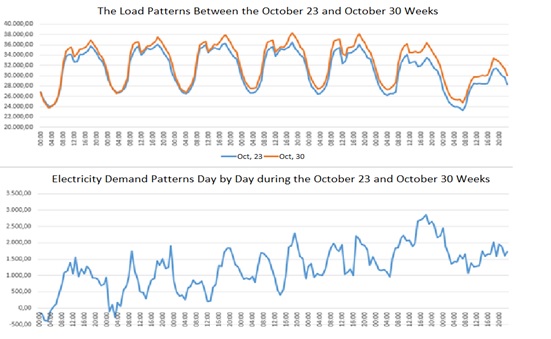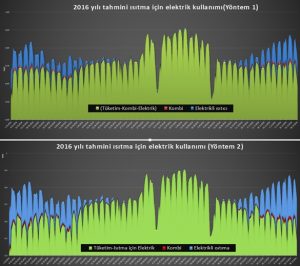 SUMMARY:
SUMMARY:
How much of the electricity demand in Turkey is used for spatial heating? The answer to this question is neither easy nor there is a solid methodology for deduction. Therefore, the calculation methods in this study are completely open to debate and should be considered as a draft for a more realistic study.
METHODOLOGY:
Two methods have been used in this study.
First method: The amount of electricity consumed by an average household boiler(pump) is calculated to be close to 3kWh, with a maximum daily consumption of 12m³ of natural gas per boiler and the 80% capacity factor that it will spend for this operation. Estimated electricity consumption of boilers for each 1 Turkish Lira worth of gas consumption is 9 kuruş.

Using this method, electric demand of boiler motors’ operations was calculated. Then, the natural gas demand for heating was calculated from the difference between the reference point(in municipal gas consumption) in July and the coldest day. The electrical heating amount was then calculated from proportioning the estimated number of electrical heaters and the operating factor of these to the city’s natural gas demand. With the estimated number of electric heaters, the operating factor of these heaters was proportional to the demand of the city gas and electric heating quantity was found. For all spatial heating, the boiler pump electric consumption and the calculated figure was added to electricity demand.
Second Method: A figure (4 kWh) was calculated by proportioning the demand for electricity and the demand for natural gas of the city between the periods believed to have the largest acclimatization demand difference– the second and the third week of May – and the coldest period – the December week.
It is assumed that the average consumption of 12-16 million m³ of gas on summer days in the cities were used for cooking and heating water. Deriving this number from the city consumption, each m³ consumption was then multiplied by 4 kWh.
ANALYSIS:
The most important problem in the first method was the exact number of electric heaters in Turkey, their usage patterns were unknown. Secondly, it would have been correct to associate it with temperature exponentially since the demand for electricity changes parabolically with heating. However, during the sudden colds of the past week, it was observed that the demand and temperature change do not draw linear lines. So, arrival of sudden cold does not cause an immediate reaction, but even if the cold then mellows the heating demand does not disappear immediately.
Comparing the Weather Underground’s data from the weeks starting by October 23rd and October 30th, we can assume that an average difference of 5°C(cold) in İstanbul, makes 2300 MW extra demand at the highest. So, each degree means 460 MW difference. Note that during the hours with the lowest demand, on the mornings of November 2nd – 3rd) at 04:00 a.m.), the first base effect occurred as 1000 MW uptake in late night demand.

It is thought – provoking, therefore, that the electricity demand is higher not during November 1st-2nd when the actual colds hit, but during the following days.
In other words, there is a “stickiness” problem in cold weather. There may be a “stickiness” problem in hot weather. If you take into account these possible calculation deficiencies, the electricity demand for heating will change according to the temperature in the previous days, the current wind speed, and the cloud coverage and sun visibility.
The result of the main differences between the two methods is that the first method deducts the share of electrical heating (heating residences etc. during cold weather) in total electricity demand per year as 10%, whereas the second one calculates it as 20%. Unlike the second method, a rapidly growing green area is observed in April, which may be as a result of an irrigation demand.

Graph – Heating and electricity demand within the Daily demand (Y – axis starts from 0.4 TWh)
CONCLUSION:
What is the effect of heating on electricity demand of Turkey? First of all, the heating demand from natural gas users can be observed from the daily difference on natural gas demand. There is an electrical demand for each m³ of natural gas heating from electrical pumps of boilers. Each m³ of natural gas heating will also be proportional to heating with electric heaters. Consequently, around 10 – 20% of the annual electricity demand is used for heating, and around 1 – 2% of this is consumed by boilers’ electrical pumps. We can say 15% average but it depends on your method.
